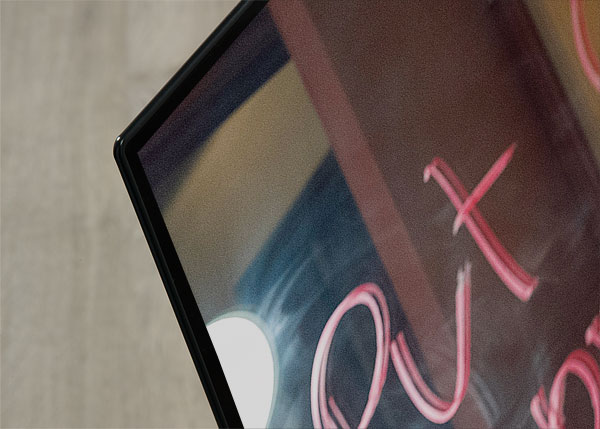LG OLED65B9 4K HDR OLED TV review

For many HCC readers, OLED remains the premier TV picture technology. Unfortunately, though, it's a technology that hasn't always screamed affordability, which is where LG's entrylevel B series comes in. Since 2018 these sets have adopted less-powerful picture processing than their higher-end stablemates, in a bid to give cash-strapped AV fans a more affordable OLED option.
In the still-current 2019 era OLED range, the 65in OLED65B9 sells for just £1,800 (and, at the time of writing, you can pick up the 55in model for just £1,100). This makes it one of the most affordable 65in OLED TVs around.
This raises two questions. First, is it worth paying extra for LG's step-up C9 and E9 series OLEDs; second, how does the B9 fare against other products in the same price range?
A Chip Off The Old Block
Comparing the 65B9 with the excellent 65C9 [see HCC #299] is the most concise way to get a handle on where this TV is at. And first impressions serve it pretty well, as its super-slim extremities and heavy-duty build quality more or less rival that of the more expensive model. Both feature down-firing (2.2-channel) speaker arrays. The only real difference is that the C9 uses a wider desktop stand.

Connections are the same, too, with highlights being four HDMIs, three USBs and the usual Wi-Fi and Bluetooth wireless options.
The HDMIs are all built to the high-frame-rate-supporting HDMI 2.1 specification; something no other brand has been able to match with their current ranges. This should futureproof the OLED65B9 for any high-frame-rate 4K gaming we might get with the next console generations. This was one area I'd imagined LG might compromise with the B9, but I'm glad it hasn't.
This TV also matches LG's C9 models with its smart features. It gets the same version of WebOS, right down to the new tweaks of a dedicated screen for monitoring and controlling smart devices on your network, and comprehensive voice control that includes built-in support for Amazon Alexa and Google Assistant, as well as LG's own ThinQ AI system.
Most of the usual video streaming apps are present, including Netflix, Amazon, Rakuten.TV and the UK's main terrestrial TV broadcasters (the latter included within a Freeview Play bouquet). 4K HDR playback is supported where a service provides it.
The only big absentee is Apple TV (despite LG supporting the company's AirPlay 2 and Homekit tools). LG has confirmed it will support Apple TV at some point, but can't currently give any arrival date.
The B9 handles the HDR10, Dolby Vision and HLG flavours of HDR like its more expensive siblings, and carries built-in Dolby Atmos decoding. There's no playback for HDR10+ content, which is annoying – but you don't get this on LG's more expensive sets, either.
The major difference between the OLED65B9 and OLED65C9 is, then, its picture processing. The more affordable set features a second generation version of LG's Alpha 7 silicon, whereas the C9s employ the second generation of LG's Alpha 9. This will lead to picture quality differences.
Out Of The Shadows
For this audition, I was able to run the OLED65B9 right alongside a C9, watching the same content on each screen via an HDMI splitter. Doing this revealed more variation between the two than I'd actually expected.
As an example, the extreme darkness of sequences inside the creature's lair during the finale of It Chapter 2 (4K Blu-ray) reveals notably more shadow detail on the C9 model, which makes the caverns and tunnels appear more three-dimensional and textured. The tone of black colours is also more natural; on the OLED65B9, I found some blacks gaining a slight magenta tint.
To my surprise, however, the B9 delivers slightly deeper black levels overall than its brethren. But while this can give the TV's pictures a bit more immediate high-contrast impact, the attendant loss of some subtlety in dark areas finds the C9's images more convincing and natural.
Brightness performance on the B9 is somewhat curtailed. With a white HDR window covering around 10 per cent of the screen, the TV delivers 650 nits approx, versus around 850 nits on the C9. This is quite a significant difference, and creates a slightly duller feel to the sunny daytime shots around Derry in It Chapter Two. There's also less intensity in peak HDR areas, such as the fairground lights that provide a backdrop to the film's opening scene.
This fairground sequence is also interesting in the way it shows the B9 delivering slightly richer-looking colours. The more the scene plays on, however, revealing darker and gentler tones, the more apparent it becomes that the C9 provides more colour subtlety and tonal finesse. Skin tones, in particular, fare better.
It Chapter Two's dark scenes expose a little less refinement with near-black management on the B9 – it tends to look a touch noisier in very dark background areas. But there is an exception to this. The OLED65B9 actually suffers a little less than other LG OLED screens when it comes to elevated blocking noise during very dark moments in Amazon Prime Video's SDR streamed content. But this is likely more a factor of the TV losing shadow detail in dark areas, than it truly being better at rendering near-black content.
Sharp Shootout
This entry-level set doesn't look quite as detailed and crisp with native 4K sources as its step-up rival; a function, I suspect, of the C9's generally wider brightness range and superior colour tone rendition. It's still obviously a 4K performance, however, and worthy of your UHD disc collection.
 |
Home Cinema Choice #351 is on sale now, featuring: Samsung S95D flagship OLED TV; Ascendo loudspeakers; Pioneer VSA-LX805 AV receiver; UST projector roundup; 2024’s summer movies; Conan 4K; and more
|

















































